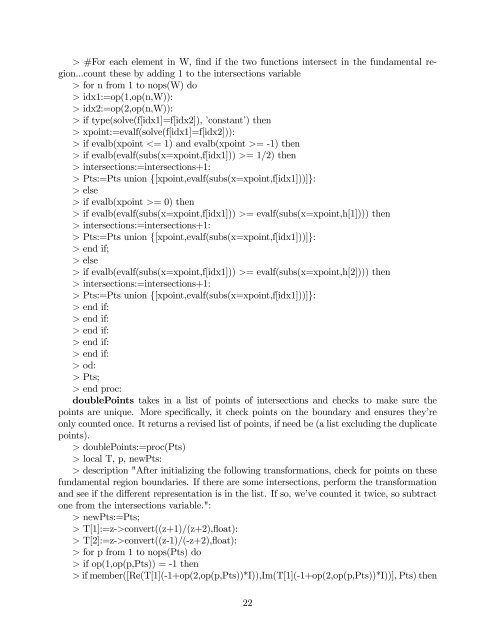The Maximal Number of Transverse Self-Intersections of Geodesics ...
The Maximal Number of Transverse Self-Intersections of Geodesics ...
The Maximal Number of Transverse Self-Intersections of Geodesics ...
You also want an ePaper? Increase the reach of your titles
YUMPU automatically turns print PDFs into web optimized ePapers that Google loves.
#For each element in W, find if the two functions intersect in the fundamental region...count<br />
these by adding 1 to the intersections variable<br />
> for n from 1 to nops(W) do<br />
> idx1:=op(1,op(n,W)):<br />
> idx2:=op(2,op(n,W)):<br />
> if type(solve(f[idx1]=f[idx2]), ’constant’) then<br />
> xpoint:=evalf(solve(f[idx1]=f[idx2])):<br />
> if evalb(xpoint = -1)then<br />
> if evalb(evalf(subs(x=xpoint,f[idx1])) >= 1/2)then<br />
> intersections:=intersections+1:<br />
> Pts:=Pts union {[xpoint,evalf(subs(x=xpoint,f[idx1]))]}:<br />
> else<br />
> if evalb(xpoint >= 0)then<br />
> if evalb(evalf(subs(x=xpoint,f[idx1])) >= evalf(subs(x=xpoint,h[1]))) then<br />
> intersections:=intersections+1:<br />
> Pts:=Pts union {[xpoint,evalf(subs(x=xpoint,f[idx1]))]}:<br />
> end if;<br />
> else<br />
> if evalb(evalf(subs(x=xpoint,f[idx1])) >= evalf(subs(x=xpoint,h[2]))) then<br />
> intersections:=intersections+1:<br />
> Pts:=Pts union {[xpoint,evalf(subs(x=xpoint,f[idx1]))]}:<br />
> end if:<br />
> end if:<br />
> end if:<br />
> end if:<br />
> end if:<br />
> od:<br />
> Pts;<br />
> end proc:<br />
doublePoints takesinalist<strong>of</strong>points<strong>of</strong>intersectionsandcheckstomakesurethe<br />
points are unique. More specifically, it check points on the boundary and ensures they’re<br />
only counted once. It returns a revised list <strong>of</strong> points, if need be (a list excluding the duplicate<br />
points).<br />
> doublePoints:=proc(Pts)<br />
> localT,p,newPts:<br />
> description "After initializing the following transformations, check for points on these<br />
fundamental region boundaries. If there are some intersections, perform the transformation<br />
and see if the different representation is in the list. If so, we’ve counted it twice, so subtract<br />
one from the intersections variable.":<br />
> newPts:=Pts;<br />
> T[1]:=z->convert((z+1)/(z+2),float):<br />
> T[2]:=z->convert((z-1)/(-z+2),float):<br />
> for p from 1 to nops(Pts) do<br />
> if op(1,op(p,Pts)) = -1 then<br />
> if member([Re(T[1](-1+op(2,op(p,Pts))*I)),Im(T[1](-1+op(2,op(p,Pts))*I))], Pts) then<br />
22

















